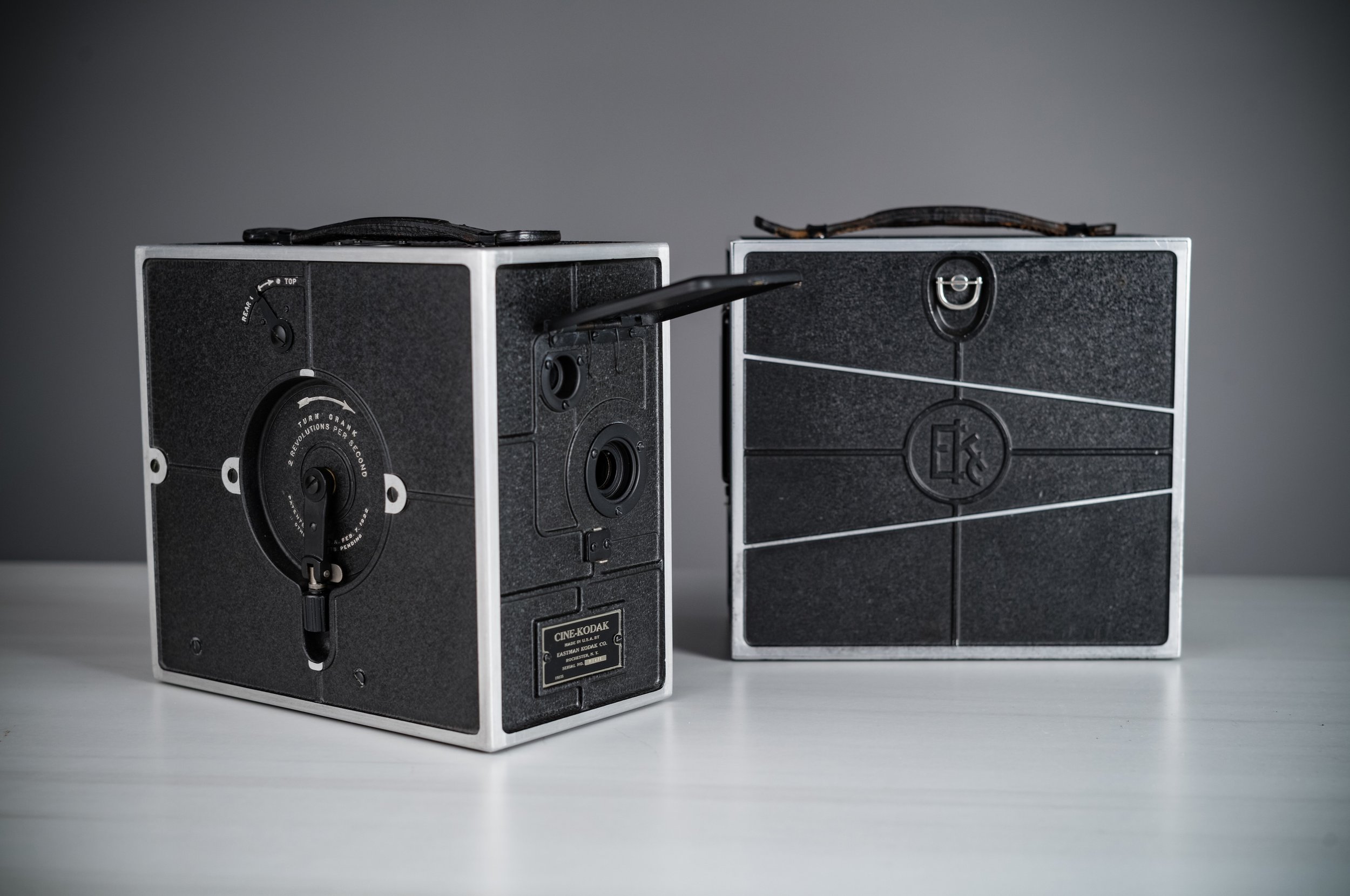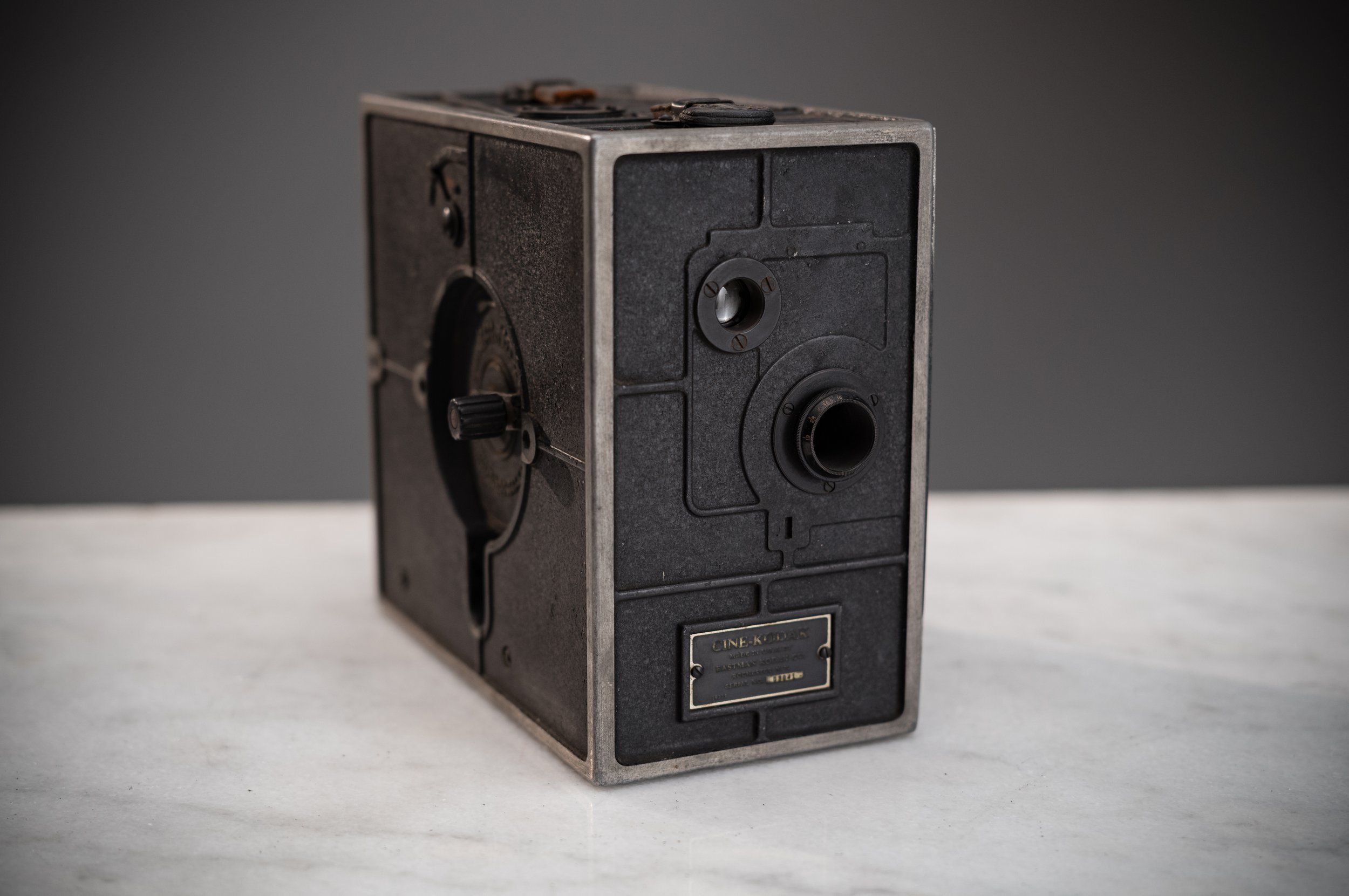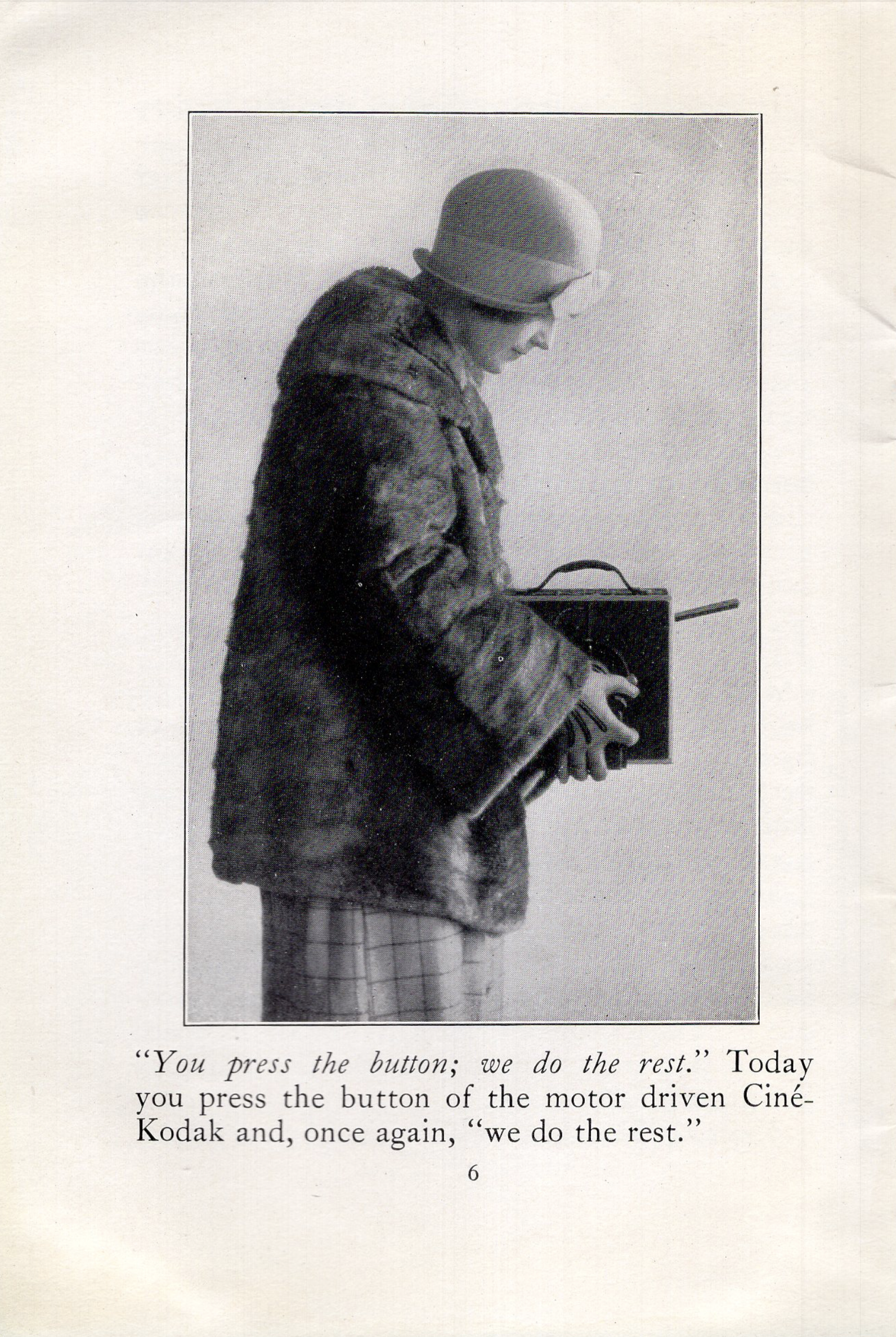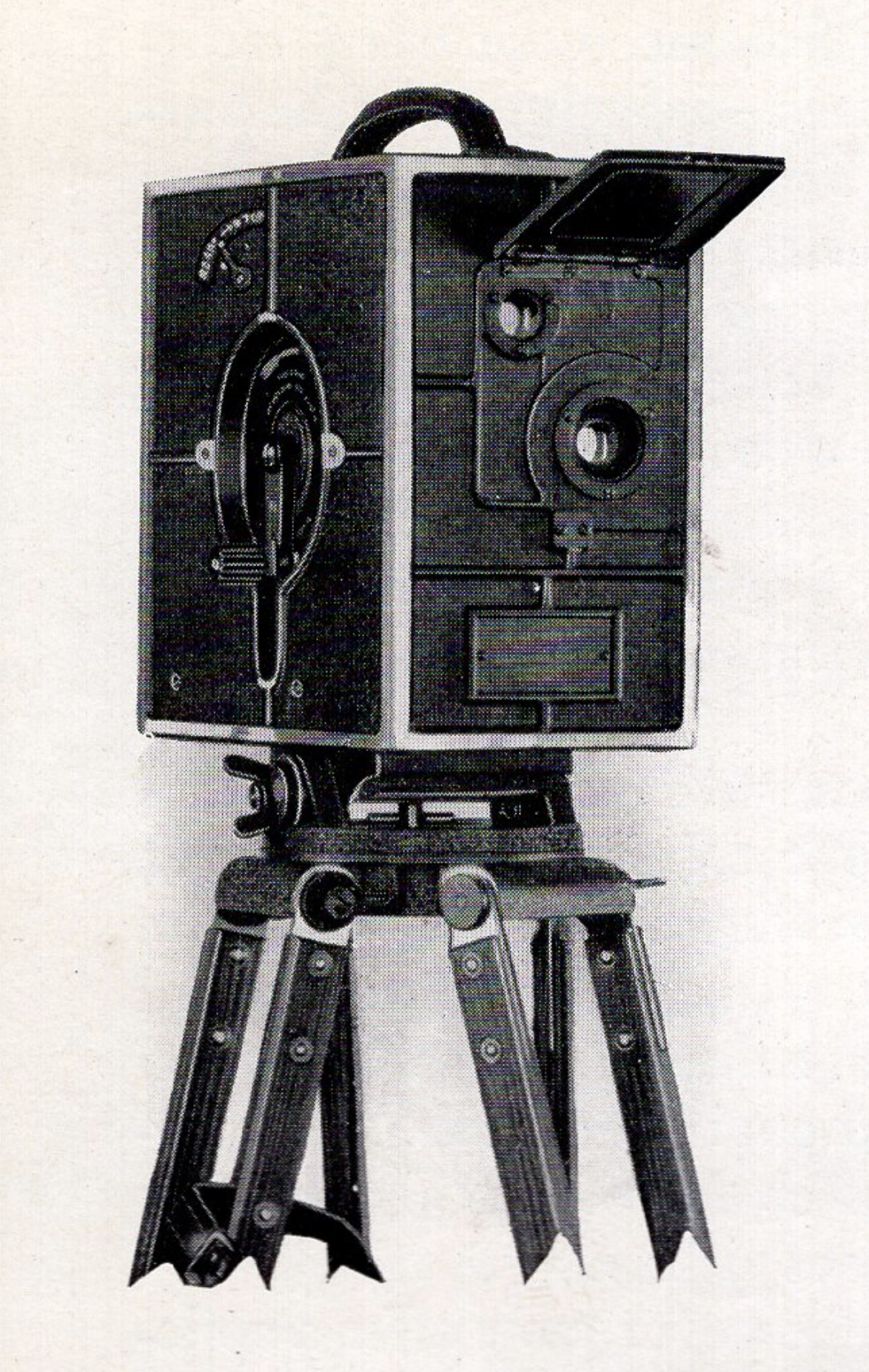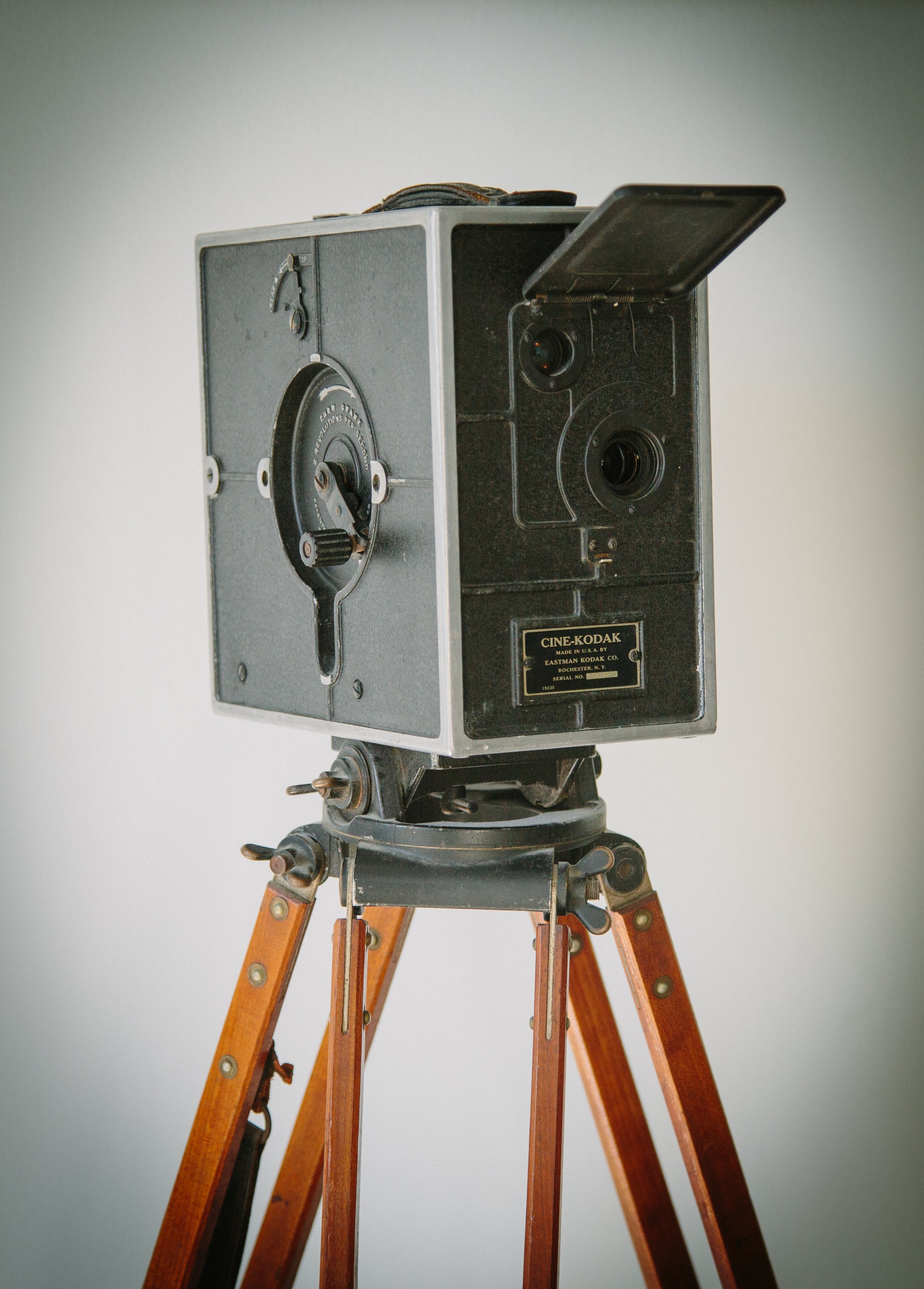Cine-Kodak Model A 16mm Cine Camera
Cine-Kodak, serial no. 01702, c1925 with its original Kodak Cine Tripod.
100 years later, a look at the first 16mm movie camera.
The original Cine Kodak 16mm movie camera holds a significant and notable place in the extensive history of filmmaking. Introduced 100 years ago by the innovative Eastman Kodak Company on July 5, 1923, it truly revolutionized the film industry by making motion picture filmmaking not only possible but also accessible to a much wider audience. The compact design and affordability of the Cine-Kodak brought filmmaking into the hands of both enthusiastic amateurs and skilled professionals alike. This remarkable camera utilized a new Kodak 16mm film format, allowing for considerably lower costs and greater flexibility compared to the larger and more cumbersome 35mm cameras that were commonly available at the time. With its introduction, the Cine-Kodak, and more importantly the 16mm film stock, sparked a transformative new era of personal filmmaking, paving the way for the democratization of cinema and inspiring countless generations of passionate filmmakers to confidently capture their unique stories on film.
c1923 Kodak Marketing Image
“Now you can make motion pictures. Kodak gave you amateur photography years ago and now Cine-Kodak opens the door to cinematography.”
These two beautiful examples of the Cine-Kodak came from the collection of the late Frank B. Mehlenbacher of Rochester, New York. The grandson of Frank Brownell, inventor and manufacturer of Eastman's early cameras including the original Brownie Camera bearing his name, these cameras are in mint condition and were never used. Serial numbers 00648 and 01476.
Cine-Kodak on location
The first 16mm movie camera
The Cine-Kodak was the original 16mm movie camera, and the first movie camera manufactured by Eastman Kodak. Along with this camera, Kodak introduced its new 16mm safety film, intending it for home use.
“It was July 5, 1923, that Kodak placed on sale in New York City the first complete 16mm. motion picture outfit - including camera, film and projector- and announced the first amateur film processing service to make possible movie making for everyone.”
In 1925 when Kodak introduced the Model B Cine Kodak, the original Ciné-Kodak was renamed Cine-Kodak Model A. The Cine-Kodak was the only hand-crank movie camera manufactured by Kodak which was operated by turning a crank on the side of the camera. The crank is turned twice per second, producing 16 frames. The later Cine Kodak models used a spring wound motor to advance the film..
The hand-crank is inside a recess on the “operator” side of the camera along with cast instructions on how fast to crank the handle. The lens and viewfinder are protected by a hinged door that springs open when the latch is released. The lens is recessed in the body under this cover just below the viewfinder window.
Fonville Winans Cine-Kodak
Operator side view
The earliest Cine-Kodak models had a single viewfinder window on the rear of the camera for the operator. Since this viewfinder image was an inverted mirror image it was difficult for amateurs to frame the subject. The Cine Kodak was originally sold as a kit which included a matching tripod, which was essential for success. Later Cine-Kodaks added a top viewfinder window for the operator that was right side up, but still inverted. It was controlled by an added lever on the operator side, just above the hand crank.
Rear of the Cine-Kodak
A large footage counter is located on the rear of the camera below the viewfinder window. Below this footage counter is a nice large focusing scale and adjustment lever. Unfortunately, the vast majority of these focus mechanisms are no longer functional due to the grease used, which seized up over time. Above and to the left of the viewfinder window is the iris scale and adjustment lever. The earliest models included a 25mm Kodak Anastigmat f3.5 lenses. Later models were upgraded to a f1.9 lens, which omitted the rear aperture control in favor of adjusting from the lens itself.
Serial No. 01476
Cine-Kodak Box
Film Loading
The camera has a cool industrial design reminiscent of the later Walter Darwin Teague designed Kodak cameras. The Cine-Kodak used 100 foot reels loaded from the side panel which included a clear threading diagram cast into the metal body. The body is cast aluminum and weighs about 7.5lbs. It measures 8” x 8.5” x 4.5”
The side panel fully removes for film loading.
Cine-Kodak Instruction Manual
Cine-Kodak Price List
Starting on July 5, 1923 the Cine-Kodak was sold as an outfit only that included a tripod, splicer, projector and screen for $335.00. A very expensive hobby for many, especially considering you could buy a new Ford Model A for not much more… then in 1924, Kodak started selling the camera separately for $125.00 with the f/3.5 lens, and beginning in 1926 with a f1.9 lens for $200.00.
Variants
Serial no. 01251- A rare variant of the Cine-Kodak Model A. Notice the lack of viewfinder on the top plate, yet it includes a casting for the later top viewfinder.
Top Plate Variants
Variations of the Cine-Kodak top plate from L-R. The earliest models did not include a waist level finder on the top of the camera, the top plate on the left is Serial number 00648. Starting around serial number 01200 about 50 examples were produced with a placeholder casting for the future waist level finder, the middle example is serial number 01251, and finally on the right is serial number 01476 with the top waist level finder added.
Rear Plate Variants
The rear focus mechanism was standard on most Cine-Kodak models until about serial number 03200 when the faster f 1.9 lens option was offered. This model omitted the rear focus lever in favor of focusing directly from the lens. The example on the right is serial number 03841. The example on the left is serial number 00648.
Serial no. 03841- The last variant with a f1.9 Lens. This version removes the rear iris control in favor of direct lens control from the front of the Cine-Kodak. Kodak also omitted the door over the lens, as it’s no longer recessed into the body.
Focus Failure
Unfortunately, most Cine-Kodaks found today have a non-functioning focus mechanism. The 100 year old grease used on the focus mechanism has dried up and formed a glue locking up the focus arm and making repair very difficult. Oddly the earliest examples produced do not have this issue, and the first batch of serial numbers can be found with a functioning focus. Kodak must have used a different type of lubricant on the earliest cameras. Here is an example of a functioning focus mechanism on serial number 00648.
A functioning Focus Mechanism on an early Cine-Kodak camera
Instruction Manuals and Cine-Kodak booklets
“You press the button; we do the rest.”
The Accessories
Kodak Motor Drive Unit
Starting in 1924, the Cine-Kodak Model A had an optional motor drive and battery. This drive was bulky and impractical requiring a large battery that necessitated special handling, but it had trouble holding a charge and tended to leak. By 1926 the Motor Drive Unit was discontinued as hand cranked cameras started falling out of favor. Newer, smaller models like the Cine-Kodak model B with a spring wound motor or the ill fated Victor Ultra Cine with a built-in motor and internal battery would enter the market.
Cine-Kodak with optional Kodak Motor Drive Unit
“The Kodak Motor Drive Unit consists of a motor which connects with the driving shaft of the Cine-Kodak; a storage battery which is located just behind the motor; a charging outfit; and necessary connections to various parts. To successfully operate the Kodak Motor Drive Unit, these instructions must be carefully followed.”
Kodak Motor Drive Unit for use with Cine-Kodak Instruction Manual
Slow Motion Attachment
An optional hi-speed crank was later available as an accessory. This would crank the film at a higher frame rate resulting in a slow motion effect. It could also be adapted to single frame recording with a gear adapter.
Cine-Kodak Tripod & Revolving Tripod Top
Originally, the Cine-Kodak was only sold with its companion tripod and head as Mr. Eastman wanted to be insured his customers obtained steady footage. Later the camera was sold separately.
“‘With a tripod, however, maximum steadiness during exposure is assured.’”
The Cine Kodak Tripod and Revolving Tripod Top was initially only sold as a package with the camera, but later was sold as an accessory. Unfortunately today, these are rarely found together partly because Kodak failed to propely brand Kodak Part #19373 with its logo and after 100 years they would get separated from their cameras. But for anyone who knows, the iconic look is hard to miss, with its matching baseplate to the design of the original Cine Kodak.
Missing is the extremely rare tilt handle which threads into the hole on the back of the head. Ive never seen one of these in person, but a reference photo is shown below.
The Cine-Kodak Tripod and Revolving Tripod Top originally sold for $25.00 or $335 as an “Outfit” with the camera, hand crank, Tripod, Kodascope, splicer and screen.
1924 Cine-Kodak Catalog
1923 Cine Kodak Tripod and Revolving Tripod Top
1923 SMPE Symposium
In May, 1923 less than two months before its official release Kodak presented two white papers to the Society of Motion Picture Engineers at their annual conference. Although both the camera and 16mm film were discussed at earlier events, this was the first technical presentation of the new format.
Society of Motion Picture Engineers Convention
SMPE Symposium
Atlantic City, New Jersey
May 7th to 10th, 1923
Presented by C. E. K. Mees
Director of Research and Development
Eastman Kodak Company, Rochester, N.Y.
“For use with the new substandard film described in a previous paper, the Eastman Kodak Company has developed a new motion picture camera and projector. The camera, which it is proposed to call the Cine Kodak, was designed and built in the instrument shop of the optical factory and is, on the whole, of standard type.
The lens equipment consists of a Kodak Anastigmat of 25 mm. focal length, working at f/3.5, with a focusing mechanism which can be operated from the back of the camera, the lens being focused by scale for any distance from infinity to four feet. The diaphragm control is also carried to the back of the camera, and at the center of the back is the footage indicator (Fig. 1).
The mechanism of the camera is a Lumiere cam operating a claw, the film being fed by a single sprocket to the gate and thence back to the wind-up spool (Fig. 2). A special feature of the camera is the finder, which passes through the box from front to rear and gives a large clear image. Since the finder is not exactly in the same position as the taking lens, there would be a certain amount of parallax between the finder image and that produced on the film, especially when taking near objects. This is eliminated by a movement of the finder lens geared to the focusing movement, so that the image shown in the finder always coincides with that actually obtained on the film. The whole case of the camera is made by die casting and is a beautiful example of the die-caster's art, which has been so greatly improved of recent years.
Since it is impossible to turn steadily the crank of a camera held in the hand, even an amateur motion picture camera must be used upon a tripod, and for this purpose a special tripod has been made which is as light as possible, the tripod head being made to rotate and move in a vertical direction for the convenience of the operator.
It is not intended that the tripod should be used to produce panoramic pictures by rotating while the camera is cranked. It is extremely difficult to do this smoothly, and the result when obtained rarely gives a pleasing effect when projected, but a moving head is necessary to enable the camera to be moved in its direction rapidly in order to follow objects in the field. The weight of the camera loaded is eight pounds and of the tripod with its special head, nine pounds.
In order to load the camera, the outer cover is removed from the film spool, but the inner cover is left in position as an additional protection to the film to prevent any possible fogging during loading. The leader is pulled out to a mark and is threaded to the sprocket and gate, and back to the wind-up spool. When the camera is ready for use, the inner cover of the film spool is removed and the door closed. After the film is all wound up, the door is opened, the first cover put on the spool, which is then removed from the camera, the second cover put on, and the film is ready to be sent for development.”
“It would seem to me that the possibility of having a small camera, that presumably would be in the hands of a large number of amateurs, might be of the greatest importance in the field of news photography, providing the pictures can be enlarged to the standard size when desired. In many cases the interest in the subject would more than counterbalance any lack of the photographic perfection. If many amateurs have these cameras, we might stand a chance of getting interesting news pictures of things of national importance which might not otherwise be obtained.”
16mm Safety Film Presented at SMPE Symposium in 1923
Since this film will be available on the market as a standard film for use in amateur motion picture cameras and has already been adopted by a number of designers for use in cameras which will shortly be available, it is perhaps desirable to describe it some what in detail. The film, which is made only on slow-burning safety base, is 16 mm. wide.
Fig. 1 shows the dimensions of the film.
Cine-Kodak Patents
“My invention relates to motion picture apparatus and more particularly to cameras designed for the taking of motion pictures by amateurs. To that end, the objects of my invention are to provide a camera that is compact and easy to operate so that it can be conveniently carried around;”
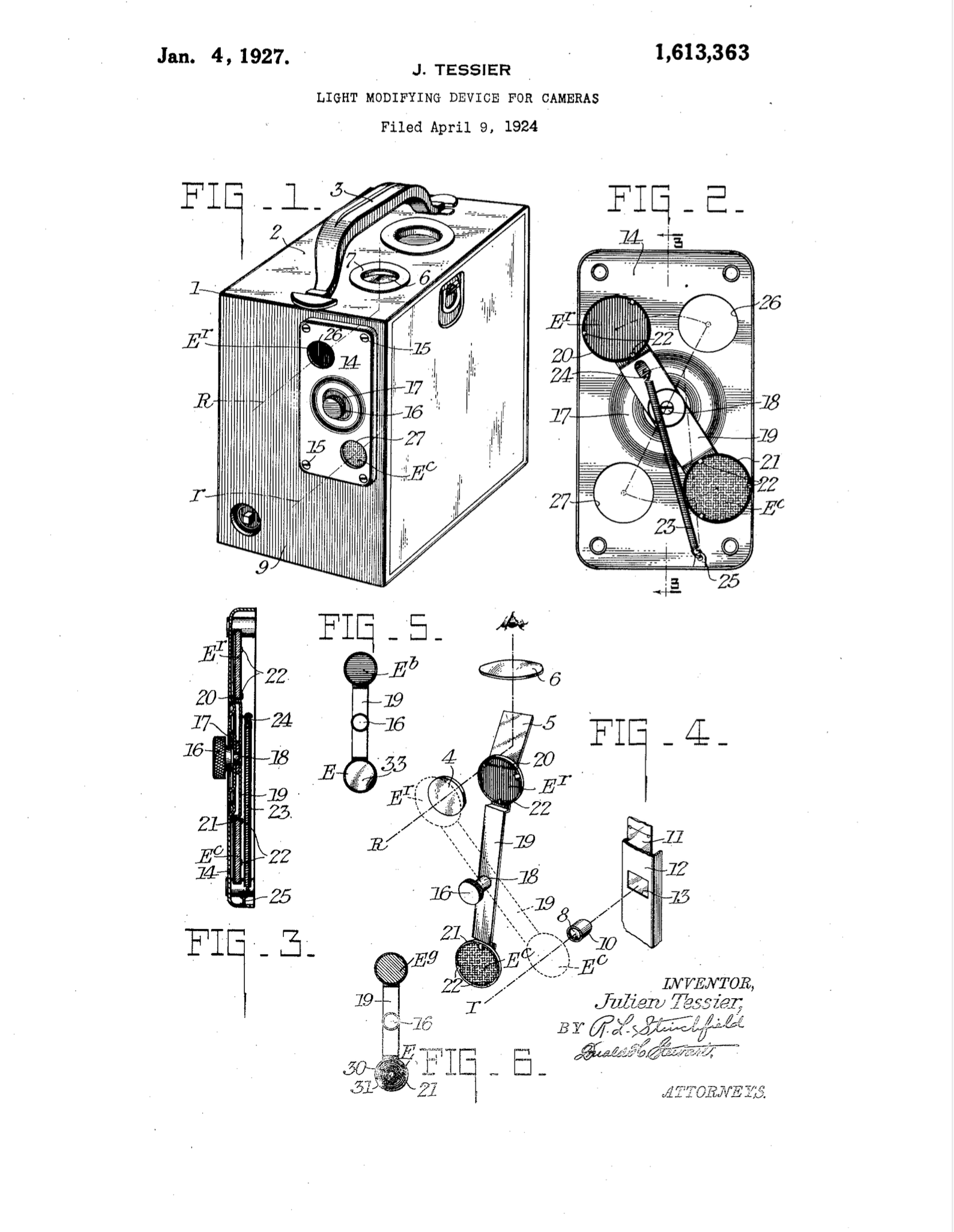
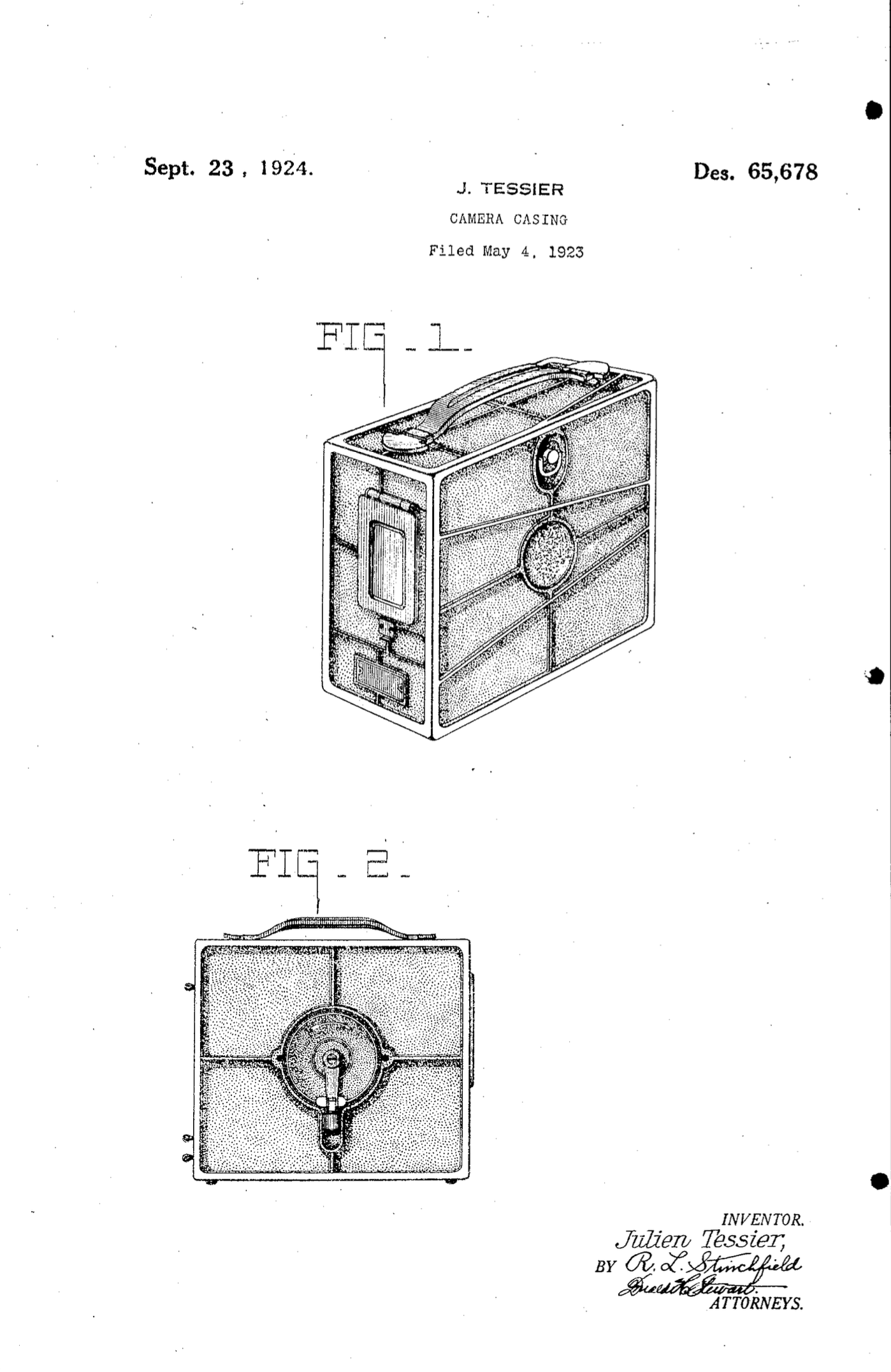
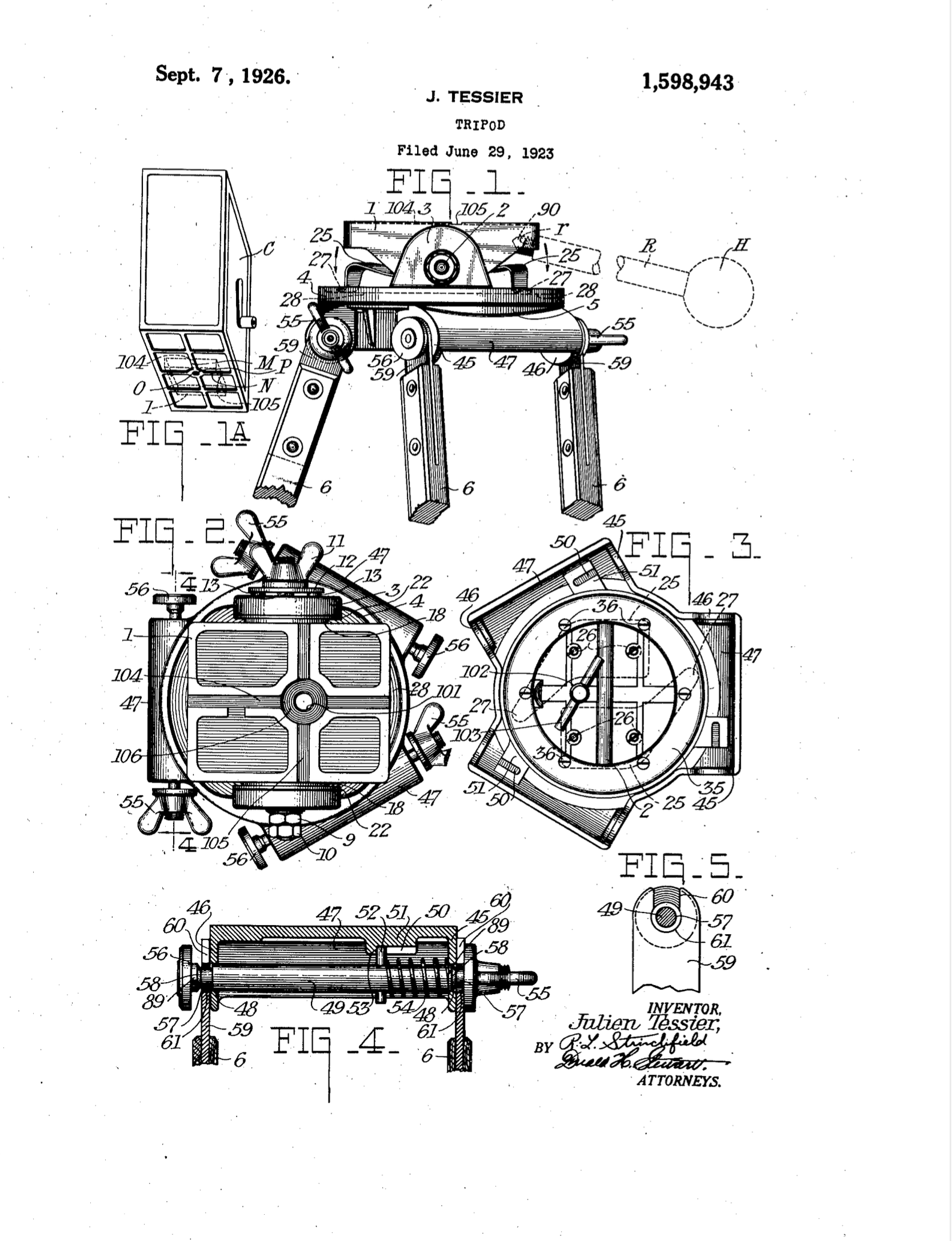
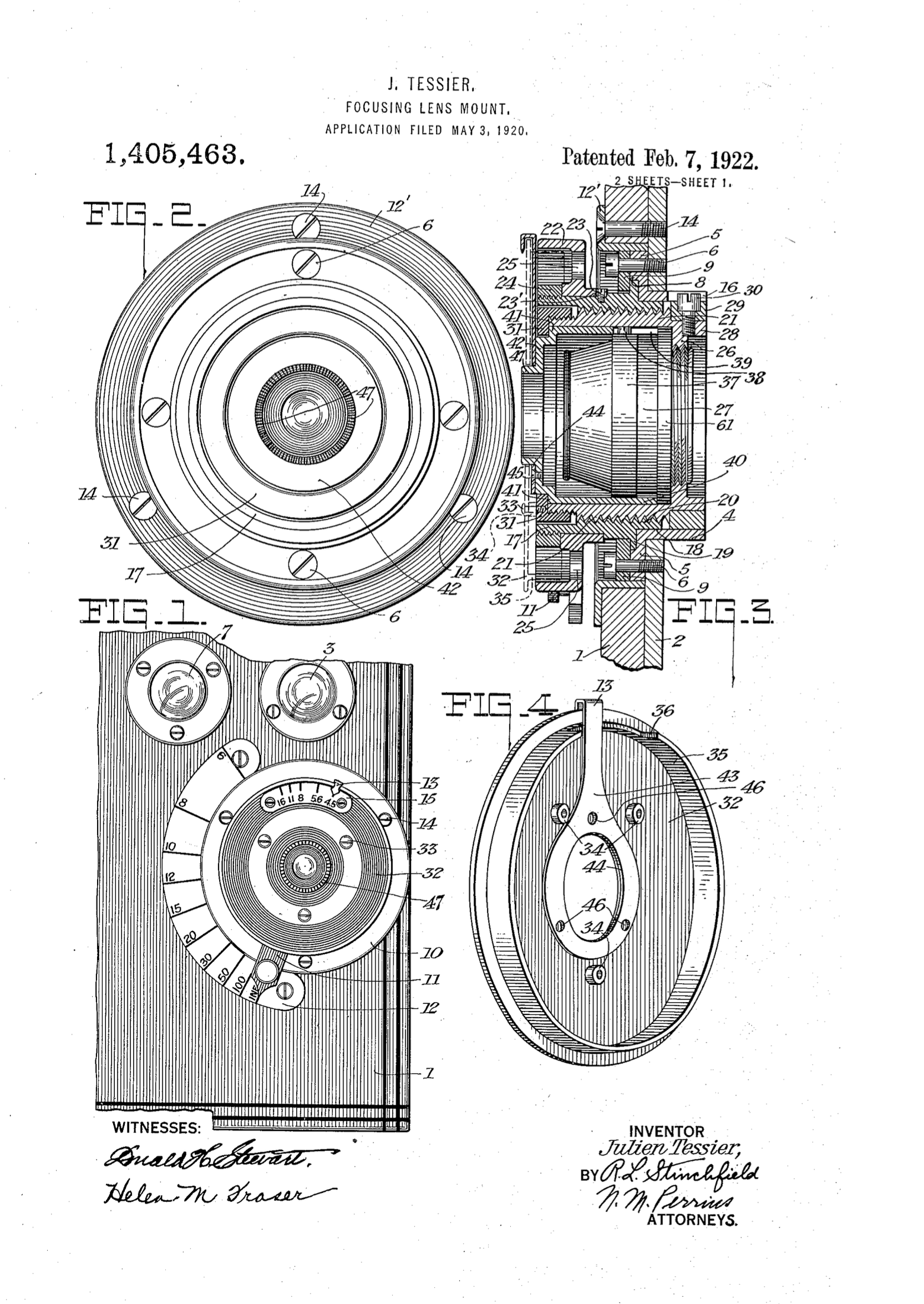
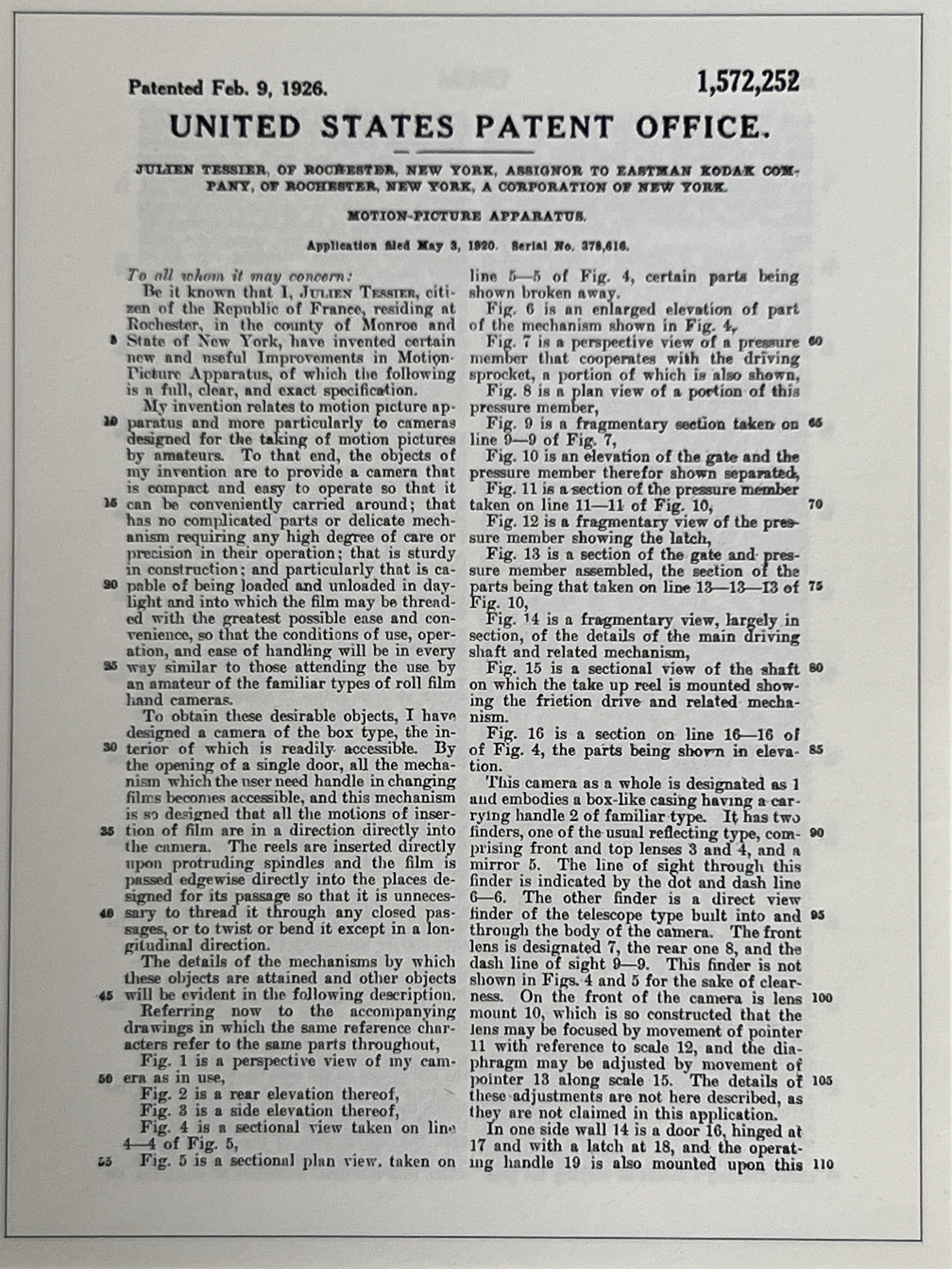
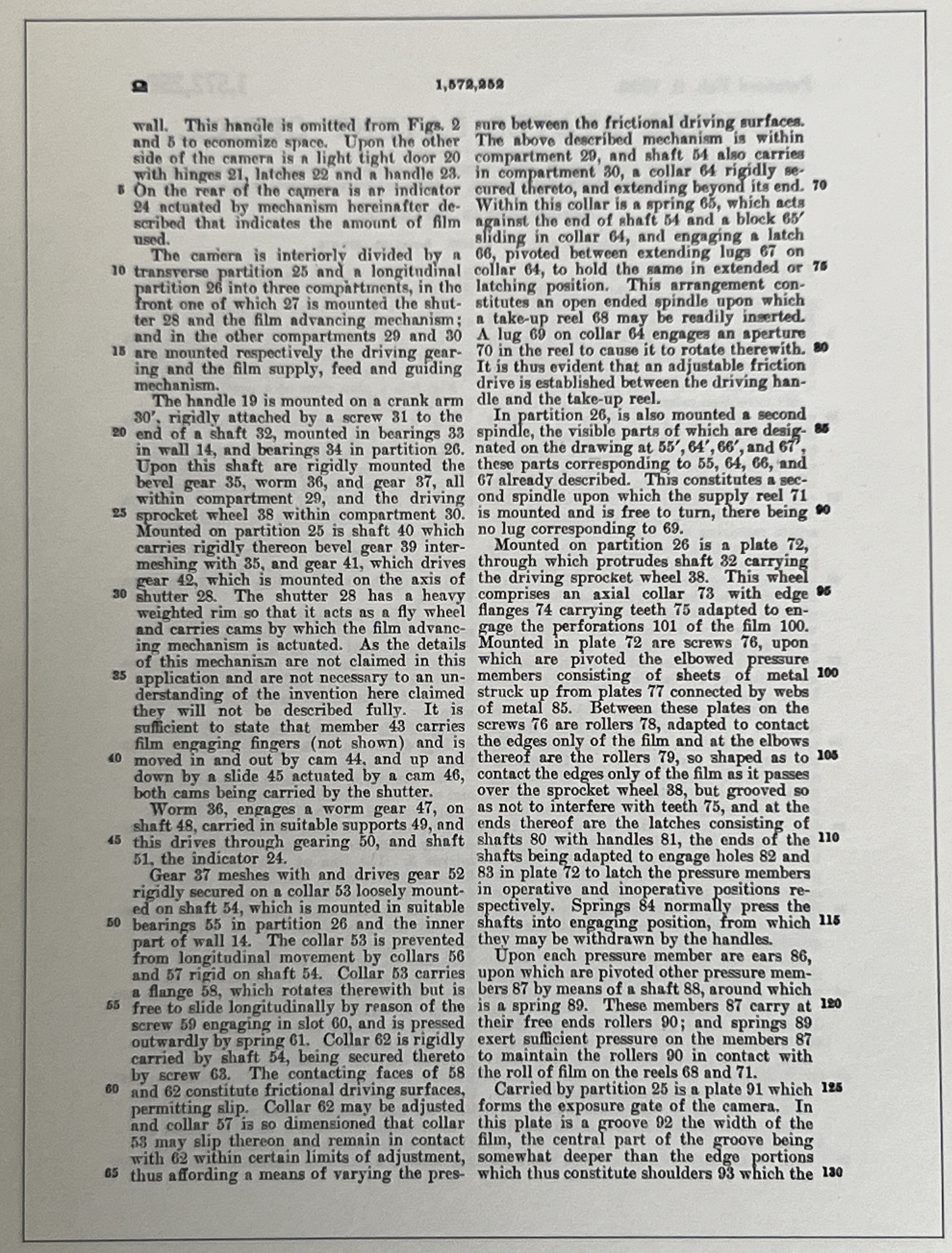
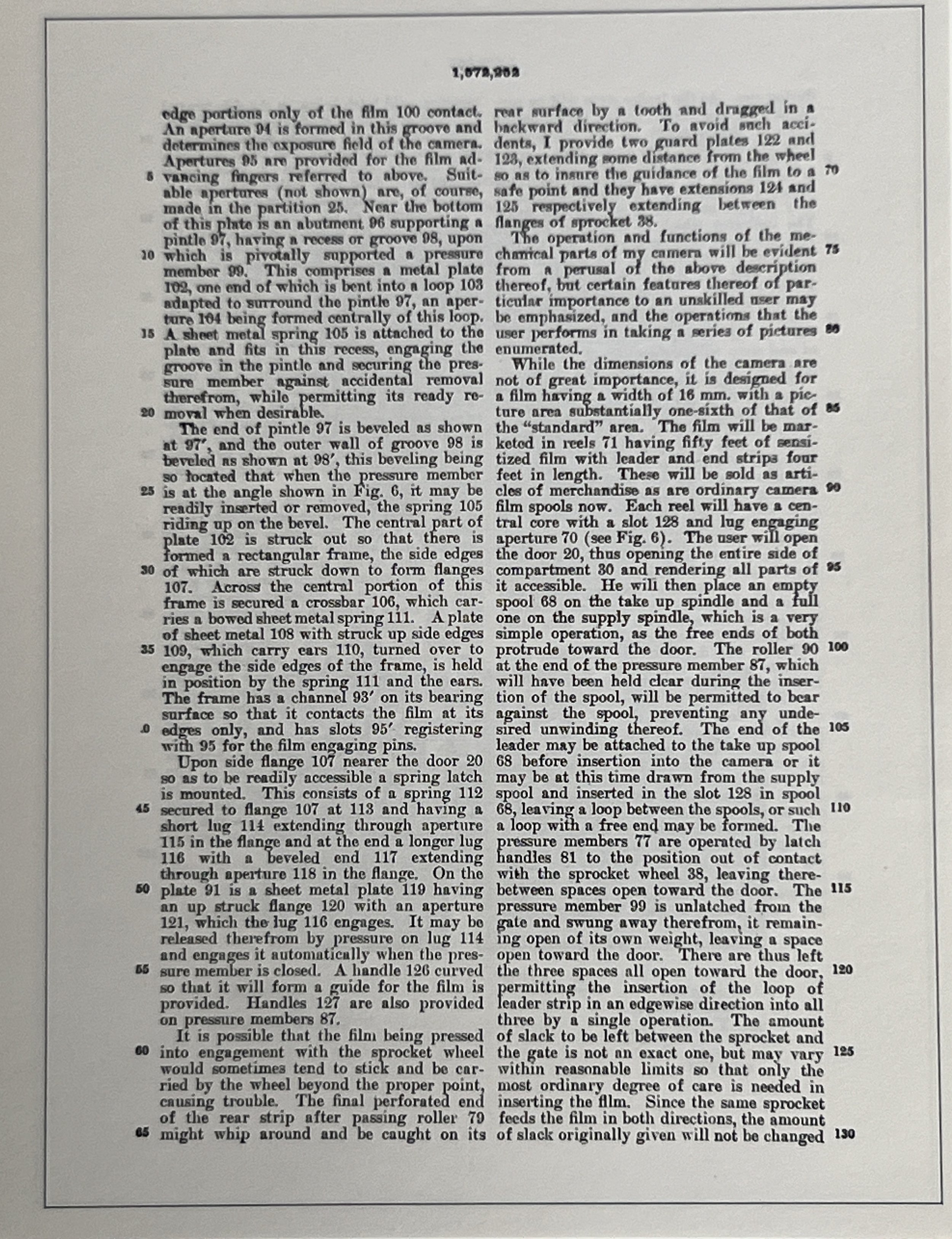
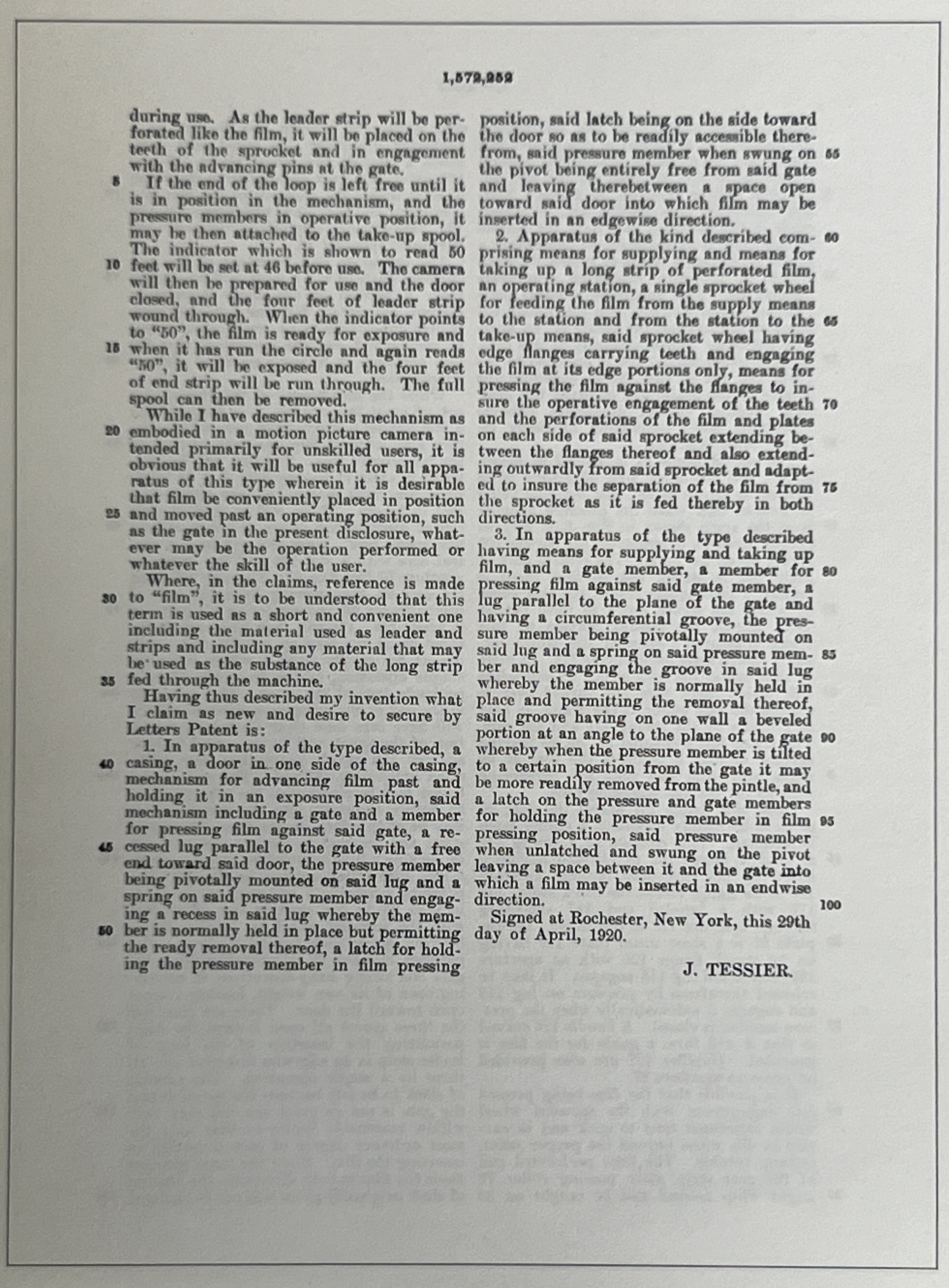

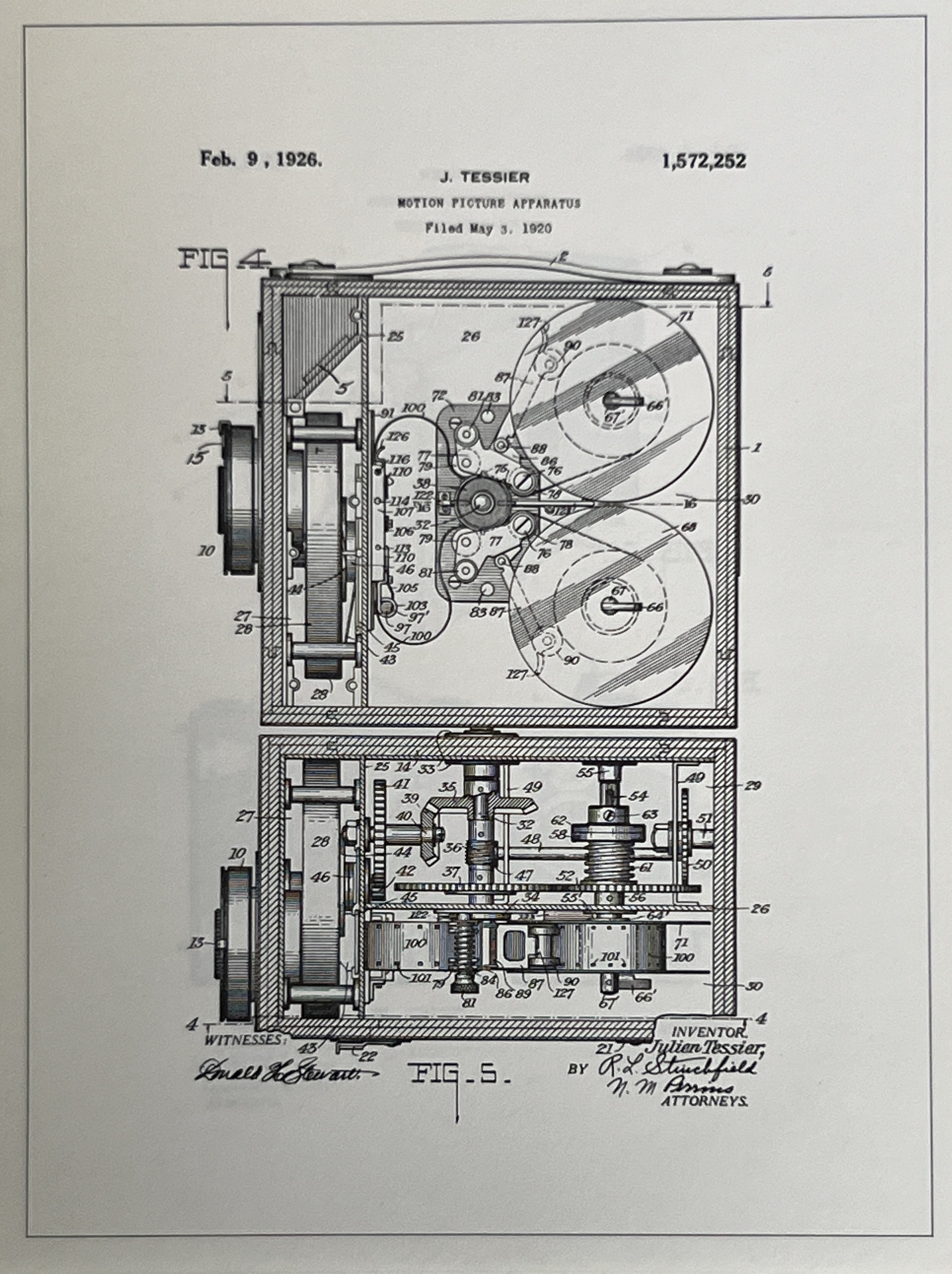
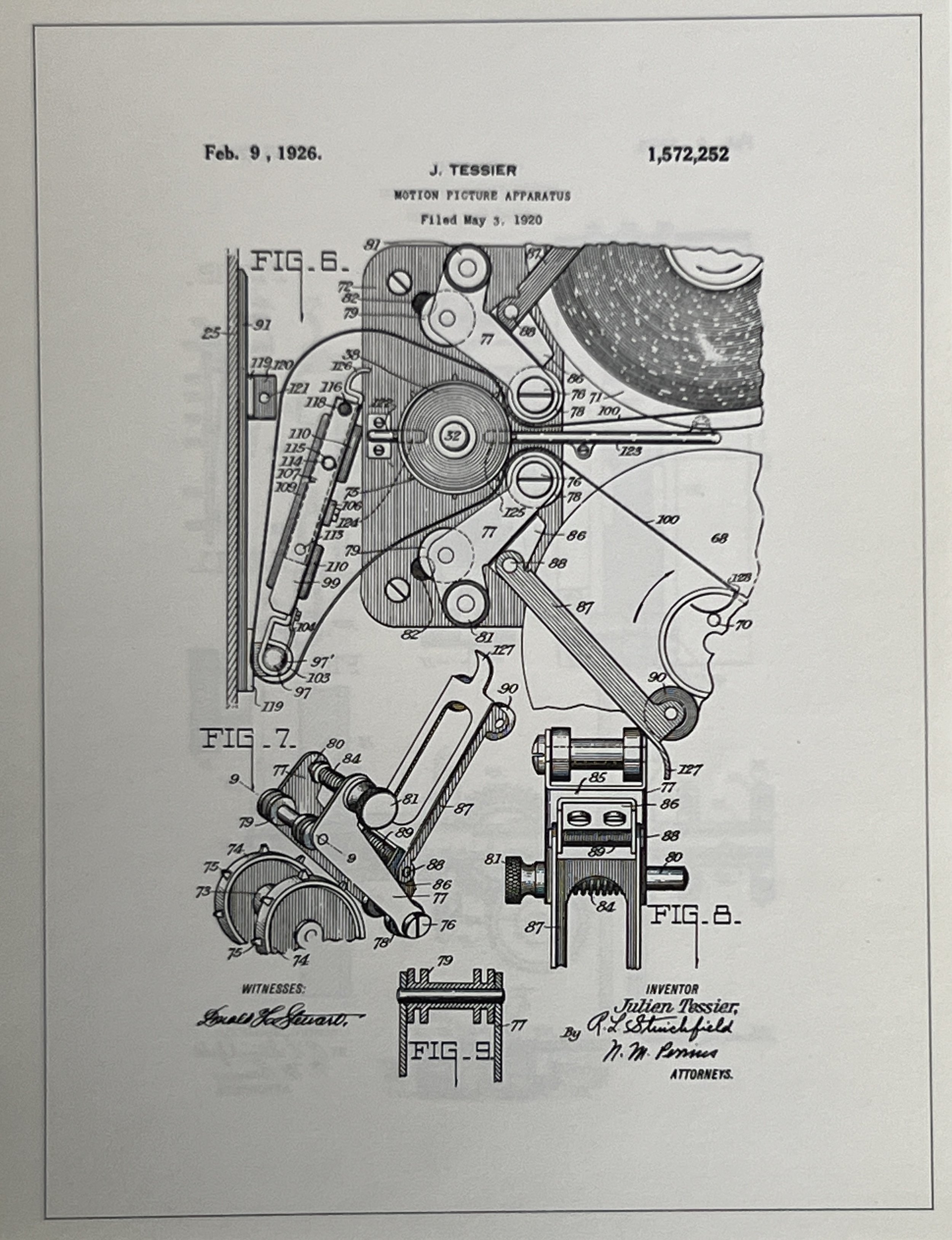
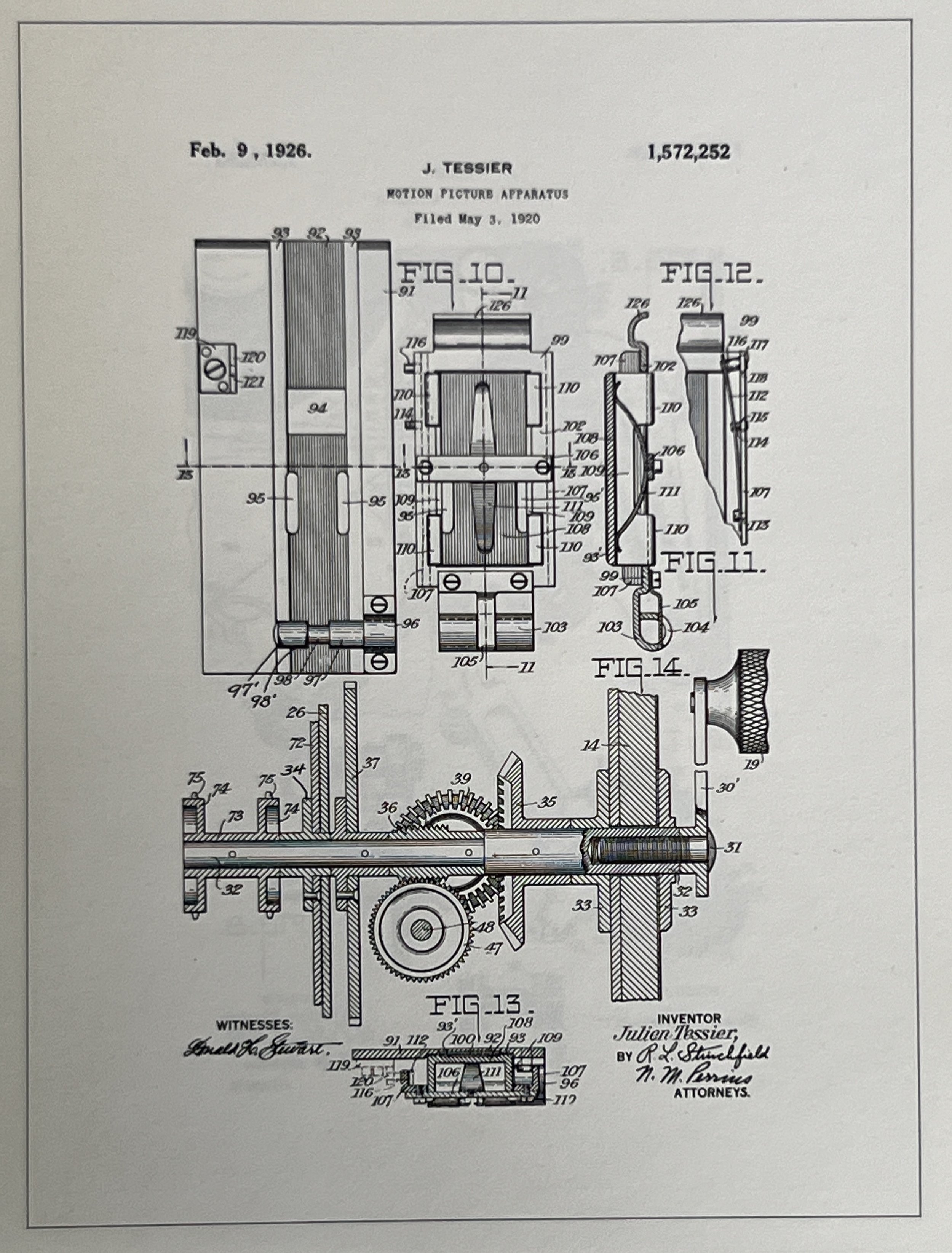
Cine-Kodak Prototype
Images from Eastman Museum
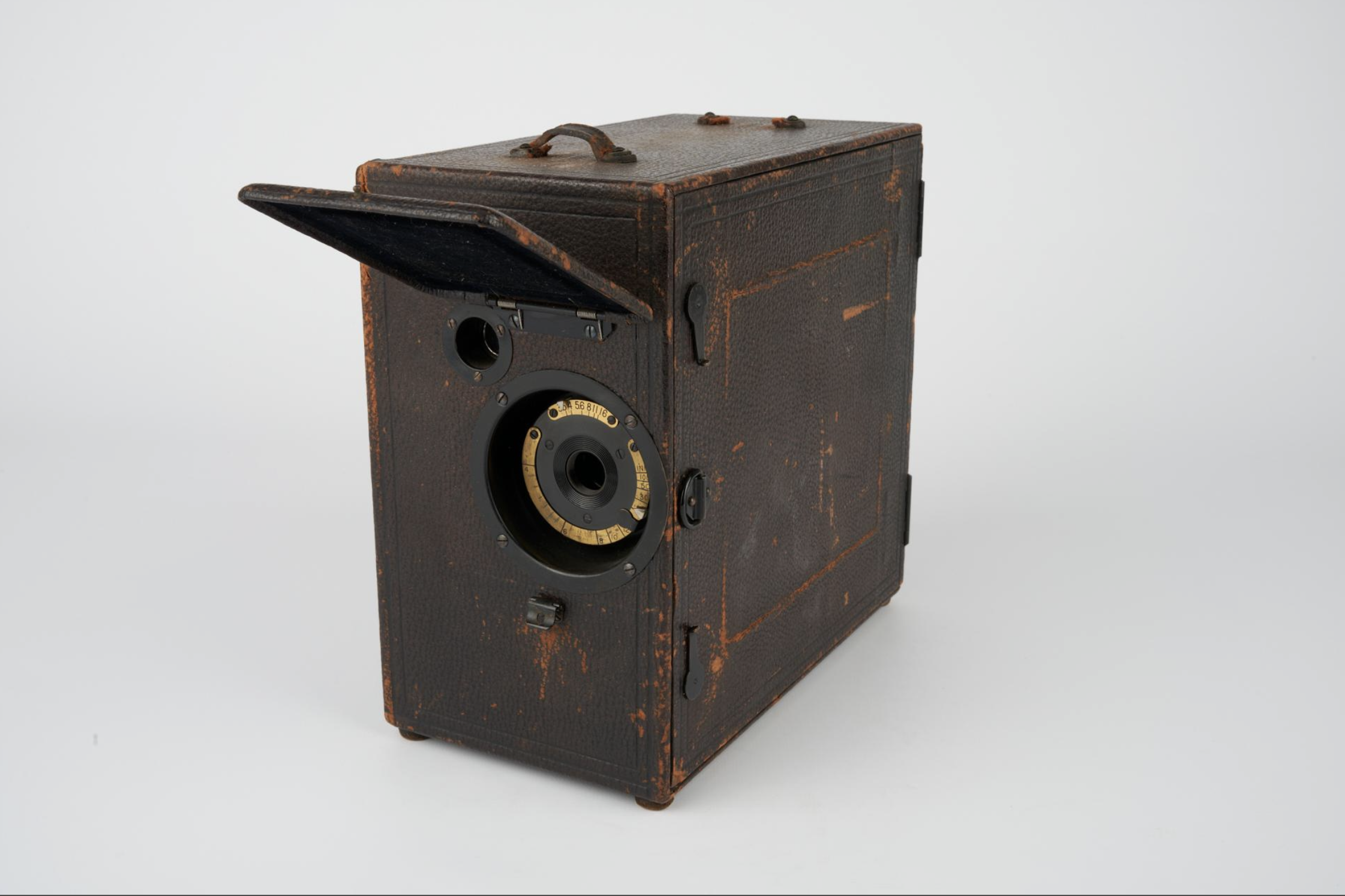
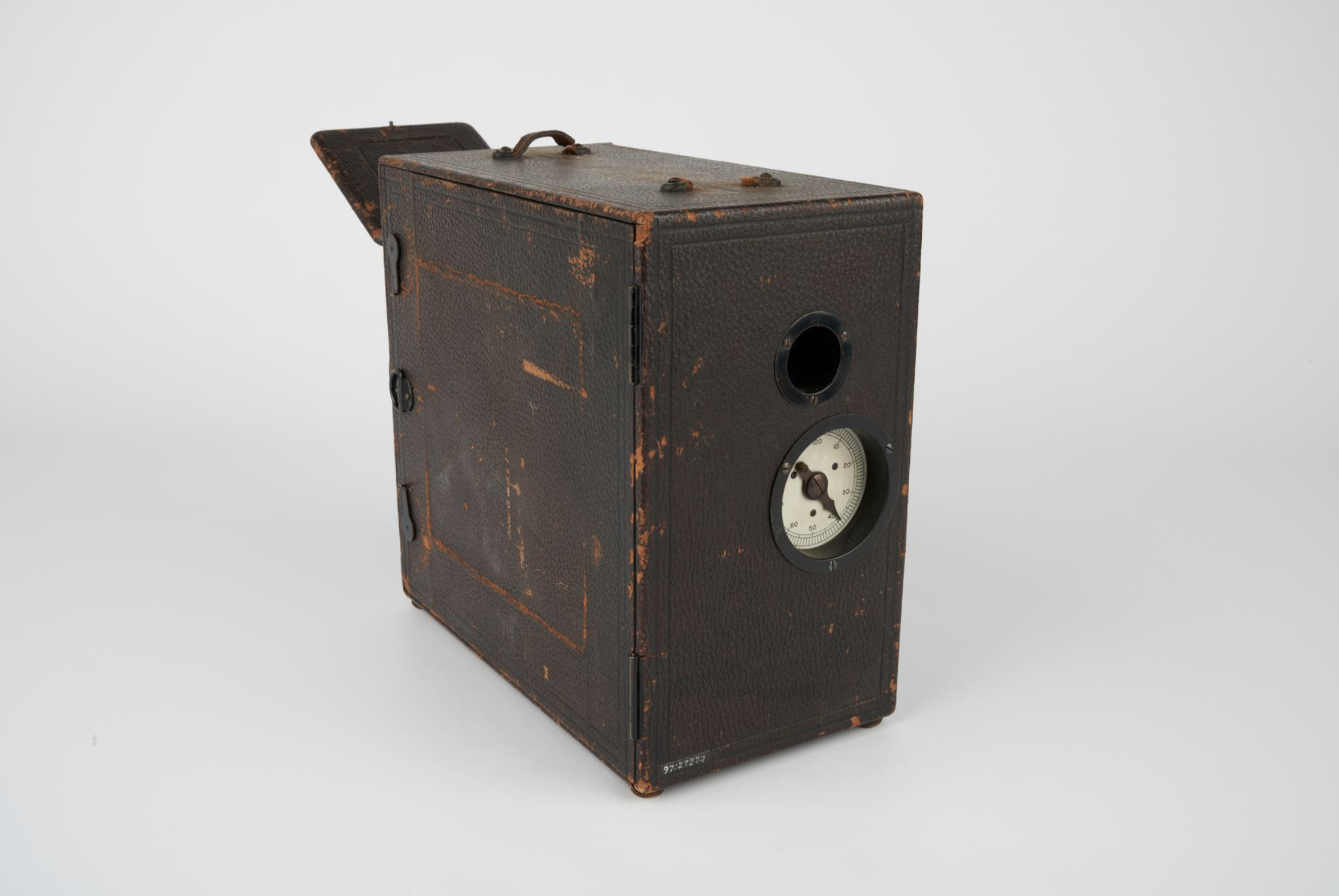
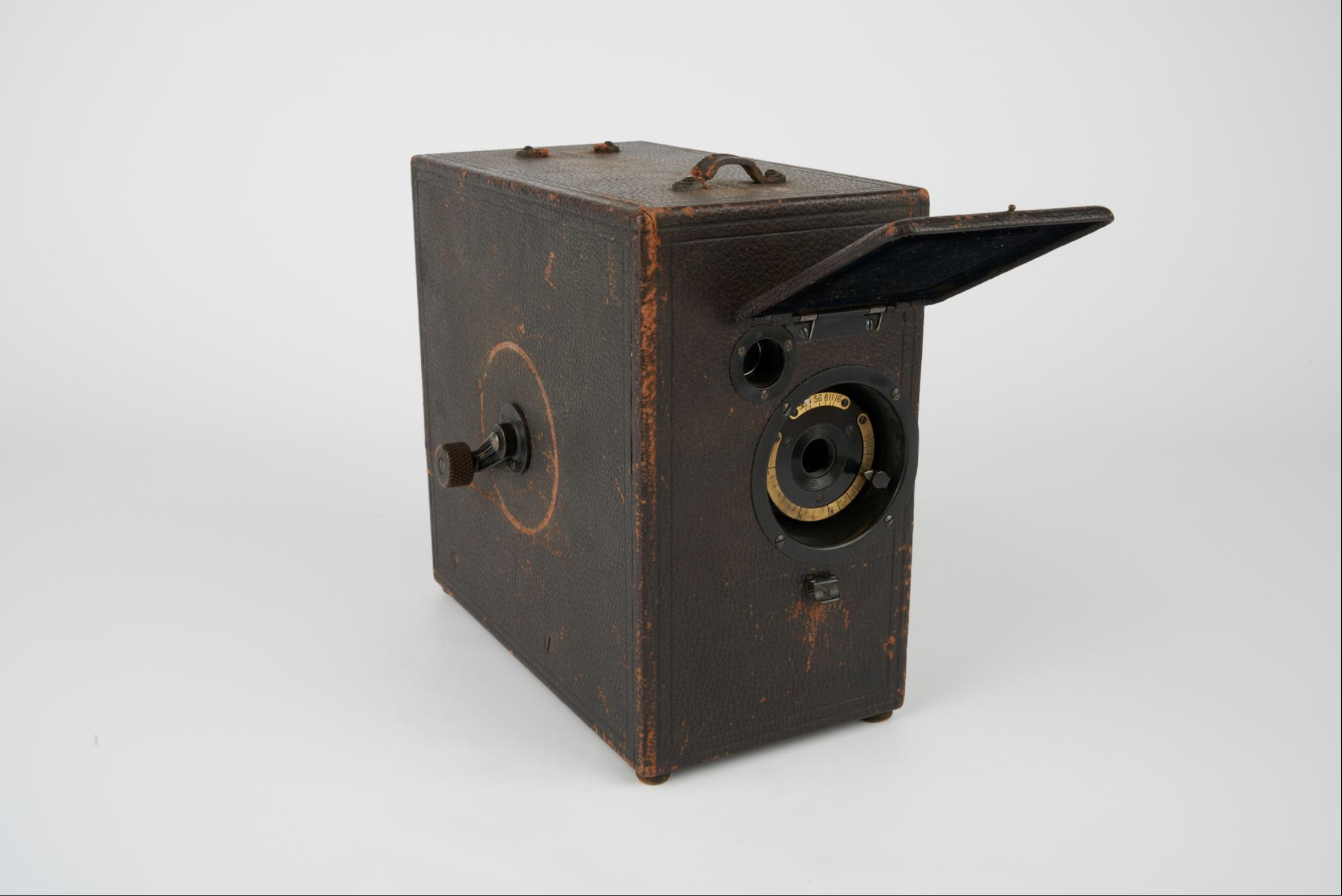
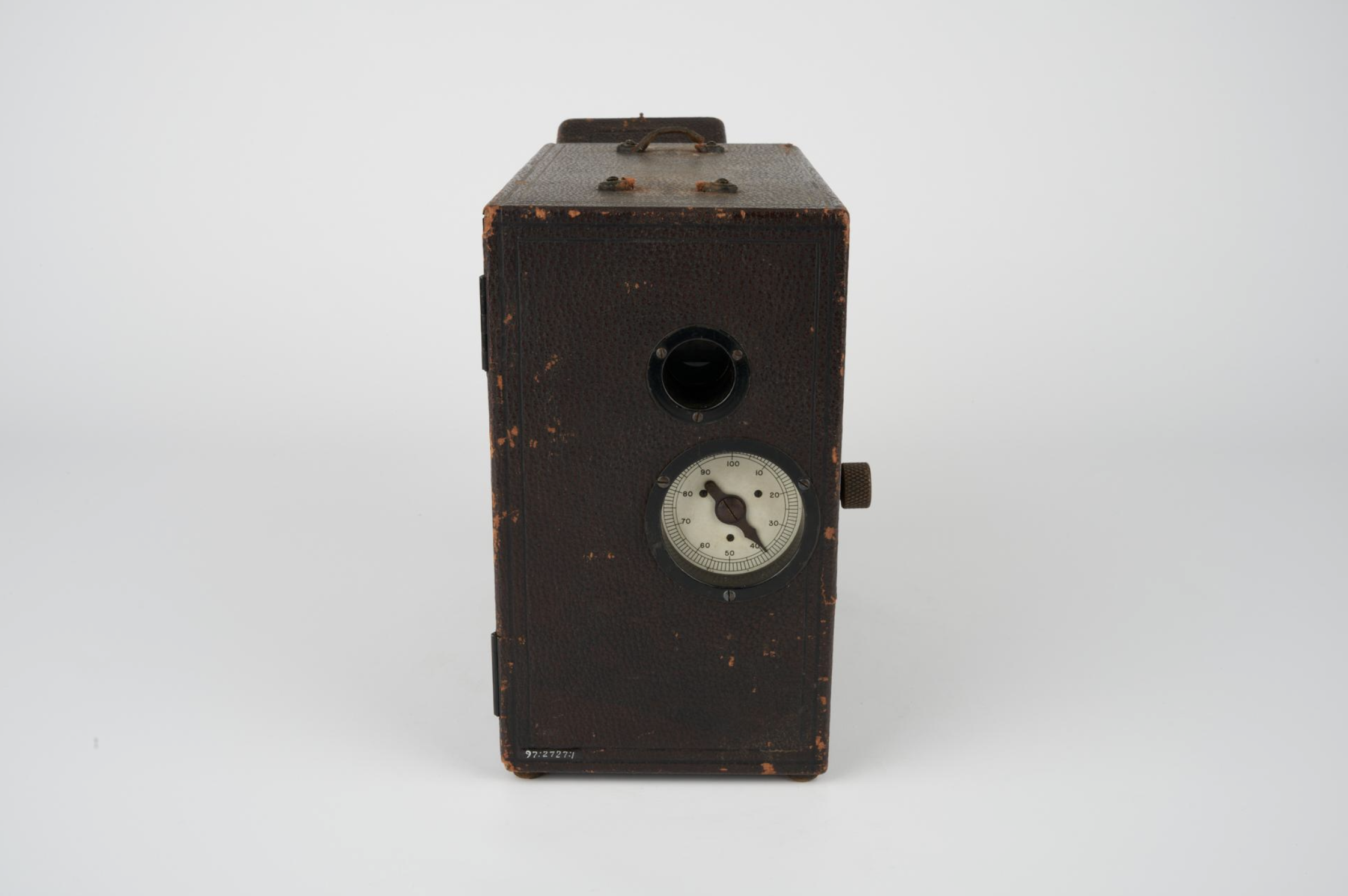
16mm film a huge success
Kodak’s 16mm ‘safety film’ had several advantages. Foremost, since the base for 16mm film was made of cellulose acetate, it was no longer combustible like previous Nitrate based films. Additionally, the introduction of this new reversal film not only resulted in significant cost reductions due to its smaller size, but it also eliminated the need for prints as it produced a positive. This innovative film revolutionized image creation, streamlining the entire journey from capture to viewing and before long was also adopted by professionals. 100 years later 16mm is still used today in productions worldwide.
“This process is the subject of an application for a patent, and its exact nature cannot therefore be revealed at the present time, but it is now possible to obtain first-class positives upon coatings of any thickness of the special emulsion, the density not being dependent upon the evenness of coating, while the control over variations of exposure is quite as good as is possible if a negative be developed and the print made from it in the ordinary way.”
16mm movie cameras gained immense popularity since the introduction of the Cine-Kodak. Later models and their compact size and lightweight design made them highly practical for filming on location, allowing filmmakers to capture footage with ease. Additionally, the affordability of 16mm film stock made it accessible to a wider range of filmmakers, including students and independent artists.
16mm film provided filmmakers with creative flexibility, allowing for experimentation, improvisation, and a more intimate approach to storytelling. These factors, combined with advancements in technology and the ability to achieve professional quality results, propelled 16mm movie cameras to the forefront of the filmmaking industry, cementing their popularity among aspiring and established filmmakers alike.
Fonville Winans shooting his film exploring the swamps of Louisiana and its people.
The Cine-Kodak inspired amateur enthusiasts, documentarians, and students to explore the art of storytelling through moving images. From capturing family moments to examining social issues, the Cine-Kodak played a role in shaping visual culture.
Fonville Winans on location with his Cine-Kodak in 1932.
Introduced just a month later for 16mm film, the Victor Cine and Victor Ultra Cine Cameras didnt fair as well.



